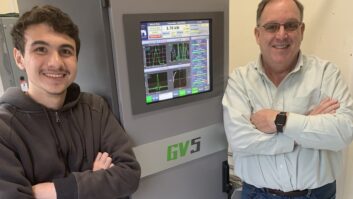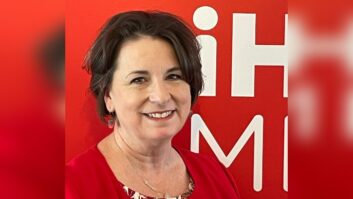BLACKSBURG, Va. With help, perhaps unprecedented, from major radio broadcast groups and equipment suppliers who donated loads of broadcast equipment and services, Virginia Tech’s non-commercial WUVT(FM) now is ready to usher in a new broadcast era.
Pending only last-minute equipment fixes, the student-run station expected to begin broadcasting at 6,500 watts with a new transmitter and antenna on nearby Price Mountain by mid-September. The station submitted radiofrequency radiation exposure measurements to satisfy the Federal Communications Commission in August and received commission approval shortly afterwards.
WUVT made headlines in April of 2007 when then-Chief Engineer Kevin Sterne was among those shot by Seung-Hui Cho in the worst mass shooting in U.S. history. Sterne, 24, survived multiple gunshot wounds to his legs.
Sterne’s story of survival also brought attention to his radio station’s plight. Faced with malfunctioning equipment and unfulfilled plans for a power increase, the radio station was in need of aid.
In stepped numerous organizations including the Society of Broadcast Engineers, which spearheaded much of the assistance efforts. Clear Channel Radio loaned the school a Harris ZX-3500 transmitter in the months after the shooting to keep the station on the air after its 24-year-old transmitter failed. Harris donated a Flexstar exciter during the equipment pinch.
The short-term fixes allowed WUVT to broadcast at its licensed 3,500 watts across the New River Valley until early this summer. At that time the station was forced to operate at significantly reduced power – about 25 watts – after renovations at Lee Hall required a temporary move of its antenna to the Squires Student Center, where the station has its studios.
In addition to equipment needs, the station, at 90.7 MHz, had several other hurdles to clear before work on the transmitter project could begin this year.
Power increase
When WUVT filed an application with the FCC for a power upgrade to 10 kW in 2008, a co-channel FM in Emory, Va., licensed to Emory & Henry College, also filed for a power increase from its original 500 watts to 10 kW. Negotiations ended with WUVT accepting a power increase to 6.5 kW to eliminate the contour overlap.
Meanwhile, WUVT also had to acquire a noncommercial FM waiver for protection from WVVA(TV), Channel 6 in Bluefield, W.Va. Doing so earlier this year allowed WUVT to modify its FCC application to use a circularly polarized antenna donated by Clear Channel. The four-bay rototiller antenna has been factory retuned by Electronic Research Inc.
WUVT is collocating at an existing tower site, approximately five miles south of Blacksburg in Christiansburg, Va., with Cumulus Media’s WBRW(FM).
Physical work on the project began earlier this year when the Virginia State Police donated a 16-by-9-foot Rohn concrete communications shelter. It was moved to the transmitter site in January, Sterne said.
“Nothing happens as quickly as you would like. It was cool and damp in early summer, which hindered some work at the site,” said Sterne, who serves as an engineering consultant at WUVT and assisted in the upgrade project. WUVT’s current CE is Chris Anna.
In late summer the station was trying to get an A/C unit to work and finish some painting.
Student aid
WUVT officials estimate they have secured nearly $150,000 in equipment donations since the campus shootings. They’ve concluded that volunteer labor brings that total to approximately a quarter of a million dollars.
Specifically, Sterne acknowledged the work of the SBE, Steve Davis, vice president of engineering at Clear Channel Communications and Dane Ericksen, consulting engineer with Hammett & Edison.
Clear Channel donated a Harris Z5CD transmitter with DigitCD exciter to be used at the new transmission site, a Kohler generator and 150 feet of Andrew flexible air dielectric cable, WUVT officials said.
The goodwill of broadcasters and suppliers was overwhelming, Sterne said. He said Orban donated an Optimod 8500 audio processor, Burk Technology donated several items and Cumulus Media donated the tower space on Price Mountain.
“Time and time again people would step up when we asked for help, or even when we didn’t. This has been quite an experience,” Sterne said.
Ericksen, who conducted the channel study and completed much of the application preparation, said it is somewhat unusual for the FCC to require actual RFR exposure measurements.
“However, the WUVT antenna is unique because it has 0.968 wavelength interbay spacing and 1.8 degrees of electrical beam tilt since the antenna was originally designed for a different FM channel,” Ericksen said.
Considering the circumstances of the collocation, he said a “measurements condition” was not completely unexpected for the multi-user site.
WUVT officials said they have money budgeted for the RFR field measurements.
Sterne, who joined the radio station as an undergraduate in 2003, expects to graduate with a master’s degree in electrical engineering in December.
“I have no plans beyond graduation just yet. Graduation is next on my agenda,” said Sterne.












